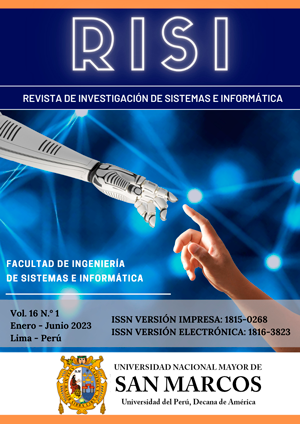Prototype of an automated hydroponic NFT greenhouse with two microclimates for the home based of Internet of things
DOI:
https://doi.org/10.15381/risi.v16i1.25581Keywords:
NFT Hydroponic Greenhouse, Automated Greenhouse, Internet of Things, MicroclimateAbstract
Ensuring food security and sustainability at the global level is one of the current major challenges. This challenge is intensified by the various prospects for population growth and conventional farming methods that are unable to meet the global demand for food. In the last decades, with advancing technology, automated hydroponic greenhouses have been gaining prominence in agricultural fields and urban areas including homes. One of the technological applications highlighted is to enable constant control monitoring of ideal parameters for cultivation. Thus, this article aims to design and implement a prototype of an automated hydroponic greenhouse with the NFT (Nutrient Film Technique) system with two microclimates for the home, bringing practicality to the user with the autonomy of the system and obtaining various plants, vegetables, or vegetables free of fertilizers, good quality and low cost. The microclimates of the greenhouse are intended for a variety of plants, including medicinal, aromatic or ornamental plants, as well as short and long-stemmed vegetables and vegetables. Market research was performed as a first stage for the validation of low fidelity in order to know the potential customers, plants, and vegetables of customer preference as well as the appropiate dimensions of the greenhouse prototype to be installed at homes. After that, an Internet of Things (IoT) platform was used as an engineering project and the transmission of the measured data through cloud computing was used to help the data process in a remote server for the control and automation of the hydroponic greenhouse.
Downloads
Downloads
Published
Issue
Section
License
Copyright (c) 2023 Maria Elizabeth Puelles Bulnes

This work is licensed under a Creative Commons Attribution 4.0 International License.
AUTHORS RETAIN THEIR RIGHTS:
a. Authors retain their trade mark rights and patent, and also on any process or procedure described in the article.
b. Authors retain their right to share, copy, distribute, perform and publicly communicate their article (eg, to place their article in an institutional repository or publish it in a book), with an acknowledgment of its initial publication in the Revista de investigación de Sistemas e Informática.
c. Authors retain theirs right to make a subsequent publication of their work, to use the article or any part thereof (eg a compilation of his papers, lecture notes, thesis, or a book), always indicating its initial publication in the Revista de investigación de Sistemas e Informática (the originator of the work, journal, volume, number and date).


